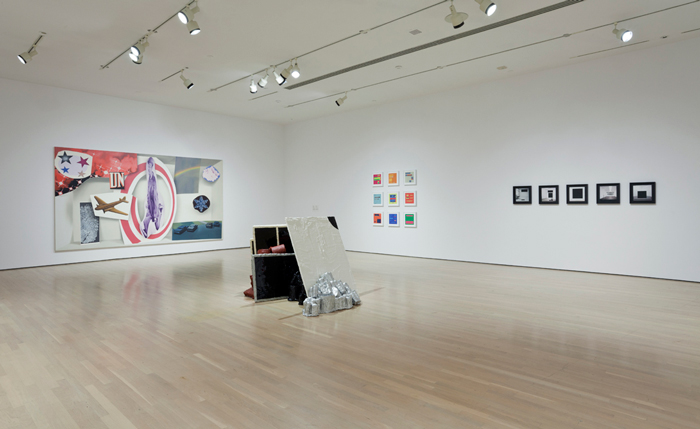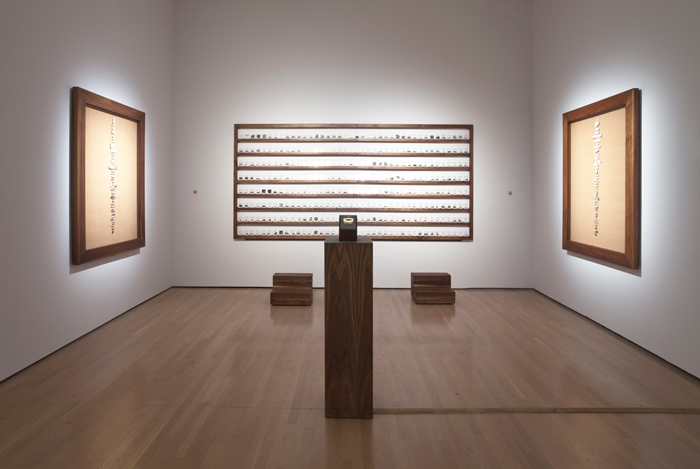
Musée d’art contemporain de Montréal. Photo: Richard-Max Tremblay
COLLAGE ON VIEW
Collages: Gesture & Fragments
at Musée d’Art Contemporain de Montréal in Montreal, Quebec, Canada
6 February-27 April 2014
Exhibition review & Curator interview
by Ric Kasini Kadour
The exhibition “Collages: Gesture & Fragments” at the Musée d’Art Contemporain de Montréal (MACM) is something of an amuse bouche of what’s happening in the world of collage at the moment. “The exhibition brings together the work of eight artists who employ techniques of collage (as well as decoupage and montage) to very different ends and evoke distinct historical traditions,” writes curator Lesley Johnstone.
One of the museum’s two curators, Johnstone, conceived the idea for “Collages: Gesture & Fragments” out of a desire for companion programming for the MACM’s exhibition of Christian Marclay’s epic work, The Clock (2010), a 24-hour montage of thousands of film excerpts that sync in real time. Prior to working at MACM, Johnstone was the was Artistic Director of the International Garden Festival at the Jardins de Métis/Reford Gardens, the head of publications at the Canadian Centre for Architecture, and spent a number of years writing and editing critical texts on a number of important contemporary Canadian artists.
Those familiar with the elasticity of the collage medium will be impressed by Johnstone’s ability to reach out to the edges of the medium and include work like David Elliott’s painting Chutes; Thomas Corriveau’s 16-mm film Kidnappé, or Trevor Mahovsky and Rhonda Wheppler’s sculpture Prop. These works, while firmly engaged with a collage mentality, are far away from the traditional cut-and-paste roots of the medium. More familiar examples of collage include Paul Butler’s abstract decoupages of Artforum ads, where the artist has removed the textual information, and Luanne Martineau’s The Lack of It the Dream, a large sprawling wall-work.
The most traditional collage work in the exhibition is Louis-Philippe Côté’s Data. In this series of thirty works, the artist presents a scrapbook of provocative imagery slapped together, piled onto the page until it is filled; lots of cars exploding, nudity, and women in sexual positions. Data trades in the poetry of teenage angst, the WTF feed on Reddit, and some of the darker corners of 4Chan while avoiding those corners of the internet that would cause federal agents to knock at your door. “The at times shocking confrontation of imagery from newspapers and magazines explicitly reflects the bombardment of images we are subjected to every day, particularly the prevalence of representations of the female body,” explains Johnstone.
“Collages: Gesture & Fragments” is not an exhaustive treatment of the medium by any means nor is the exhibition a deep investigation of the medium’s place in contemporary art. Simply a snapshot of work by eight artists, it offers an interesting starting point for thinking about the diversity of the medium.
RIC KASINI KADOUR: How did “Collages: Gesture & Fragments” come about?
LESLEY JOHNSTONE: We were thinking through programming ideas, and I proposed the show as being a good counterpoint. Often how we program at the museum is to try and find exhibitions that work well together. We had just received Chutes (2007) by David Elliott as a donation from the artist. That was the starting point. I’ve been interested in collage in general. I’ve done a number of exhibitions that are thinking about ideas of materiality. For me, collage is one of those practices where different kinds of approaches to materiality are being worked out through their artists.
The idea was not to specifically make an exhibition about collage, but to bring together a small selection of works by artists thinking about collage and are exploring different ways of making collage.
KADOUR: “Collages: Gesture & Fragments” is a relatively small exhibition that explores the collage work of eight artists, only one of whom has a practise solely focused on collage. It is not a survey of the medium by any means, is it?

2011.Courtesy of the artist and Galerie Division, Montreal. Photo: Richard-Max Tremblay
JOHNSTONE: No, it’s not. At the same time, I wanted to hit on all different kinds of work. I didn’t want it to all be collage you often think of. I wanted to have and to point to different historical traditions from photomontage, the German photomontage, to more conceptual work with Paul Butler….Luanne Martineau’s work is pointing to scrapbooking and Victorian collage techniques and bringing in ideas of craft. The exhibition developed as a way of circling around all kinds of different practices. When the works came together and we put them in the gallery, I was struck by the cross-referencing taking place between the works visually. You always hope when you’re curating that the whole will be bigger than each part, but that each of the parts will also be strong.
KADOUR: What were some of the common themes you discovered in the work?
JOHNSTONE: A common thread in all the works is this idea of building fragments that are built up on a surface; of collage being worked out on a horizontal surface and then brought up. Luanne Martineau’s works have the sense that she worked it out on a flat bed, like a Rauschenberg kind of idea of these things being placed on a table top, that there are surfaces that are work spaces, that things are provisional. They can be here, but they can also be moved. With the David Elliott painting, he builds a little box and then he moves things around inside that box, and then he photographs the box, and then he makes the painting. Hajra Waheed’s installation has been built up from something quite intimate. At the initial stage of all the collages, there is something intimate, and there’s not a sense of them being blown up, but there’s a sense of them being put together piece by piece by piece by piece and then they end up being….put together one by one until it feels like it’s finished.

2014. Photo: Richard-Max Tremblay
KADOUR: A tension when showing collage in a large museum space is that collage is often small and intimate and putting small gestures in a big space feels empty. Is “bigness” important to the museum experience?
JOHNSTONE: Yes, in order for it to be a dynamic space. I also wanted the exhibition to feel a bit like a collage. Louis-Philippe Côté’s work has to be looked at very closely and Hajra’s works you sort of go into and other ones you can see. I wanted it to be a dynamic space, so scale was important.
KADOUR: A difficulty collage faces as a medium is that institutional collections often do not identify work as collage. As a result, while an institution many have a number of collage works, they are invisible to researchers and curators. Is that a historical anomaly that will eventually be fixed or is collage doomed to the mixed-media obscurity?
JOHNSTONE: It’s doomed in a way. David Elliott calls his painting collage, but we would never tag that as a collage. Luanne Martineau’s two framed pieces would be considered collage, but probably not the big inkjet print, but maybe because of the cutting and pasting and everything. I don’t know.
KADOUR: Collage is an incredibly diverse medium. It’s all over the place and often splashes into other mediums. In addition to problematic classification of the medium in general, there seems to be a lack of understanding of different approaches and styles within the medium itself. Do you find collage to be poorly understood?

Musée d’art contemporain de Montréal. Photo: Richard-Max Tremblay
JOHNSTONE: Yes, a number of people said to me, ‘Collage, I can do that every day at home, why would I be interested?’ I think there is a little bit more attention being paid to collage these days because we are in moments of transition politically and socially. Collage comes up at those times because it is a way of thinking through ideas that’s relatively quick, as opposed to a painting practice that can take a long time. In some cases, artists use collages as a kind of note making or sketches for other works. But a lot of times, at least the ones in this exhibition, they are a way of thinking through ideas and thinking through this really dense visual world in which we live where everything is clashing all together; how to organize this plethora of images that are circulating everywhere we go all the time into something that makes sense to them. I like collage because it feels like you’re getting closer to the process, to the thinking. There’s this tentativeness that I really like.
KADOUR: You like to see the process in the work.
JOHNSTONE: Yes. In all work, I like to see that, to feel that tension between the process itself and then this moment when the work is ready to be sent out to the world. I think collage gives you access to that.
This article originally appeared in Kolaj #8. Read more HERE.
